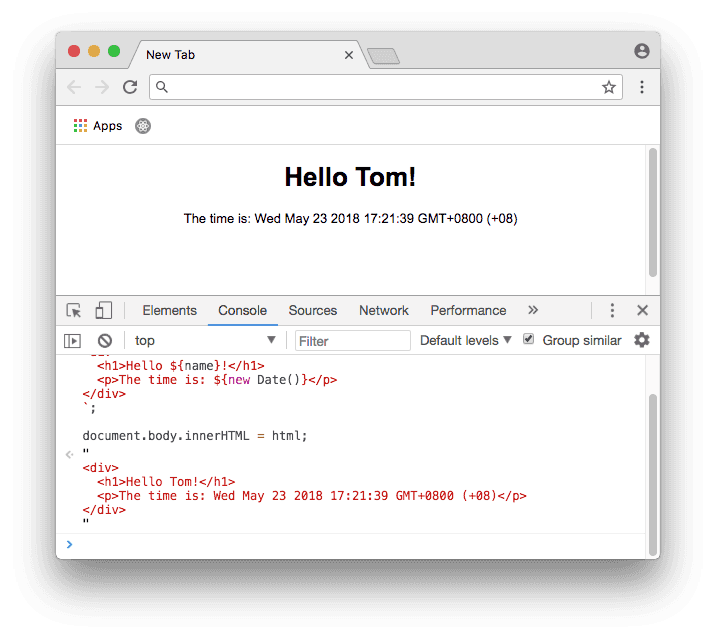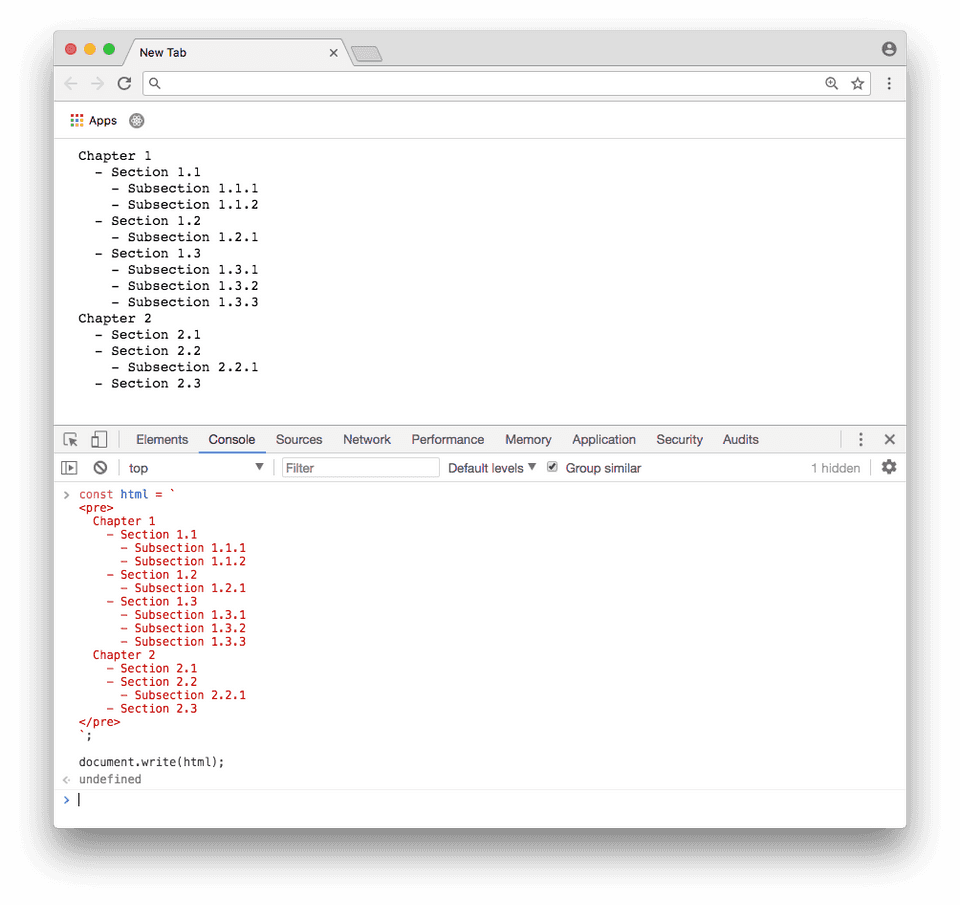Javascript 101
2.3 String Enhancements
2.3 String Enhancements
In ES6, we can use backticks (``) to
create multi-line strings and to support template literals.
Multi-line Strings
// previously:const msg1 = "first line\nsecond line";console.log(msg1);
//now//no need to escape new lines using \nconst msg2 = `first linesecond line`;console.log(msg2);Template literals
More importantly, the backticks (``)
syntax allows us to do string interpolation. What this means is that we can
now embed javascript values in the strings itself without having to concatenate
(+) and enclose strings with quotes (" " or ' '). This is achieved using
the ${ variable_or_expression } in string enclosed by backticks
(``)
const person = { name: "John", location: "Singapore",};
const greetings = `Welcome ${person.name}!I know you are from ${person.location}.`;
console.log(greetings);//Welcome John!//I know you are from Singapore.The string interpolation also works with expressions.
console.log(`1 + 1 = ${1 + 1}`);function formatMessage(gender, firstName, lastName) { return `Hi ${gender === "M" ? "Mr" : "Ms"} ${firstName} ${lastName}`;}
const msg1 = formatMessage("M", "John", "Doe");console.log(msg1); //Hi Mr John Doe
const msg2 = formatMessage("F", "Jane", "Doe");console.log(msg2); //Hi Ms Jane DoeIn addition to expression, it could also be a function call.
function foo() { return "foo";}
console.log(`hello ${foo()}`); //hello fooIt is also possible to return another template literal from a template literal. This can be useful to generate html fragments.
const array = ["item1", "item2", "item2"];const list = `<ul>${array.map((item) => `<li>${item}</li>`).join("")}</ul>`;console.log(list); //<ul><li>item1</li><li>item2</li><li>item2</li></ul>Common Usecases
Dealing with strings having both ' and "
const html = `<a href='http://www.yahoo.com'>Yahoo</a><a href="http://www.google.com">Google</a>`;More readable strings / codes
const name = "Tom";const html = `<div> <h1>Hello ${name}!</h1> <p>The time is: ${new Date()}</p></div>`;
document.body.innerHTML = html;

Dealing with a lot of newlines and tabs
const html = `<pre> Chapter 1 - Section 1.1 - Subsection 1.1.1 - Subsection 1.1.2 - Section 1.2 - Subsection 1.2.1 - Section 1.3 - Subsection 1.3.1 - Subsection 1.3.2 - Subsection 1.3.3 Chapter 2 - Section 2.1 - Section 2.2 - Subsection 2.2.1 - Section 2.3</pre>`;
document.write(html);

Generating URL for AJAX requests
function doSearch(keywords, page, limit) { const url = `http://somedomain/items?q=${keywords}&page=${page}&limit=${limit}`;
console.log(url);
//...}
doSearch("books", 1, 20);//http://somedomain/items?q=books&page=1&limit=20Tagged Template Literals
Tagged template literals is an advanced feature which allows you to define a function to process template literals. It is not essential but can be helpful for some scenarios.
//tagged template literal function to clean bad words ('shit')function clean(strings, input) { const tokens = input.split(" "); const cleanInputTokens = tokens.map((t) => { if (t === "shit") { return "****"; } else { return t; } });
return strings[0] + cleanInputTokens.join(" ");}
const input = "how are you, it's a shit day";const msg = clean`Message: "${input}"`;
console.log(msg);//Message: "how are you, it's a **** dayIt works like a normal function with a name. When we use it with backticks
(``) template literals, the function will
get an array of the strings part as the first parameter and the "placeholders"
as one of the function parameters in order. The function can then manipulate the
inputs and return another string (not required to return a string but would
likely want to do that).
function tag(strings, name, location) { console.log(strings); //["Welcome ", "!↵I know you are from ", ".↵"] console.log(name); //John console.log(location); //Singapore
//output the original text return strings[0] + name + strings[1] + location + strings[2];}
const john = { name: "John", location: "Singapore",};
const greetings1 = tag`Welcome ${john.name}!I know you are from ${john.location}.`;Sanitize Text / HTML
As seen in the above example on clean`...`,
other than using it to clean text, it can also be used to clean HTML, stripping
aways HTML codes which might cause security issues.
String Helper Functions
ES6 comes with some String helper functions. Rather than using indexOf(), there is now some shorthand syntax for performing String manipulation that is available in many other programming languages:
- startsWith()
- endsWith()
- includes()
const name = "John Doe";
//startsWith()console.log(name.startsWith("John")); //true
//same logic but more cumbersome to writeconsole.log(name.indexOf("John") === 0); //true
//endsWithconsole.log(name.endsWith("Doe")); //true
//same logic but even more awkward to writeconsole.log(name.indexOf("Doe") === name.length - 3); //true
//includes()const s = "John Doe, Jane Doe";console.log(s.includes("Doe")); //true
//same logicconsole.log(s.indexOf("Doe") >= 0); //trueInternationalization
There are libraries (e.g.
es2015-i18n-tag) which allows you to handle internationalization.